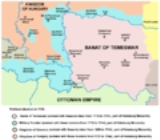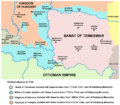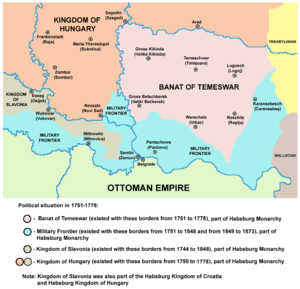
Banat of Temeswar
Encyclopedia


German language
German is a West Germanic language, related to and classified alongside English and Dutch. With an estimated 90 – 98 million native speakers, German is one of the world's major languages and is the most widely-spoken first language in the European Union....
: Temeswarer Banat, Romanian
Romanian language
Romanian Romanian Romanian (or Daco-Romanian; obsolete spellings Rumanian, Roumanian; self-designation: română, limba română ("the Romanian language") or românește (lit. "in Romanian") is a Romance language spoken by around 24 to 28 million people, primarily in Romania and Moldova...
: Banatul Timișoarei, Serbian
Serbian language
Serbian is a form of Serbo-Croatian, a South Slavic language, spoken by Serbs in Serbia, Bosnia and Herzegovina, Montenegro, Croatia and neighbouring countries....
: Tamiški Banat or Тамишки Банат, Hungarian
Hungarian language
Hungarian is a Uralic language, part of the Ugric group. With some 14 million speakers, it is one of the most widely spoken non-Indo-European languages in Europe....
: Temesi Bánság, Latin Banatus Temesiensis) was a Habsburg
Habsburg Monarchy
The Habsburg Monarchy covered the territories ruled by the junior Austrian branch of the House of Habsburg , and then by the successor House of Habsburg-Lorraine , between 1526 and 1867/1918. The Imperial capital was Vienna, except from 1583 to 1611, when it was moved to Prague...
province that existed between 1718 and 1778. It was located in the present day region of Banat
Banat
The Banat is a geographical and historical region in Central Europe currently divided between three countries: the eastern part lies in western Romania , the western part in northeastern Serbia , and a small...
, which was named after this province. The province was abolished in 1778 and administratively incorporated into the Habsburg Kingdom of Hungary.
History
Before this Habsburg province, an Ottoman province named Eyalet of TemeşvarTemesvar Province, Ottoman Empire
The Province of Temeşvar was a first-level administrative unit of the Ottoman Empire located in the Banat region of Central Europe. Besides Banat, the province also included area north of the Mureş River, part of the Crişana region. Its territory is now divided between Hungary, Romania, and Serbia...
existed in this region. Although after Austro-Ottoman war (1683–1697) and before the treaty of Karlowitz (1699) most parts of Banat were temporarily controlled by the forces of Prince Eugene of Savoy
Prince Eugene of Savoy
Prince Eugene of Savoy , was one of the most successful military commanders in modern European history, rising to the highest offices of state at the Imperial court in Vienna. Born in Paris to aristocratic Italian parents, Eugene grew up around the French court of King Louis XIV...
, the treaty recognized the Ottoman sovereignty over the region with the fort of Temeşvar. Spanish Succession War and the Rákóczi's War for Independence
Rákóczi's War for Independence
Rákóczi's War for Independence was the first significant attempt to topple therule of Habsburg Austria over Hungary. The war was fought by a group of noblemen, wealthy and high-ranking progressives and was led by Francis II Rákóczi Rákóczi's War for Independence (1703–1711) was the first...
in the Habsburg Kingdom of Hungary caused the Habsburgs to turn their attention elsewhere, so until the 1710s there were no Habsburg attempts to gain any territories from the Ottomans.
In the Austro-Turkish War of 1716-18
Austro-Turkish War of 1716-18
The Austro-Turkish War was fought between Austria and the Ottoman Empire.The Treaty of Karlowitz was not an acceptable long-standing agreement for the Ottoman Empire...
, Prince Eugene of Savoy
Prince Eugene of Savoy
Prince Eugene of Savoy , was one of the most successful military commanders in modern European history, rising to the highest offices of state at the Imperial court in Vienna. Born in Paris to aristocratic Italian parents, Eugene grew up around the French court of King Louis XIV...
conquered Banat from the Ottoman Empire
Ottoman Empire
The Ottoman EmpireIt was usually referred to as the "Ottoman Empire", the "Turkish Empire", the "Ottoman Caliphate" or more commonly "Turkey" by its contemporaries...
. It received the title of the Banat of Temeswar after the Treaty of Passarowitz
Treaty of Passarowitz
The Treaty of Passarowitz or Treaty of Požarevac was the peace treaty signed in Požarevac , a town in Ottoman Empire , on 21 July 1718 between the Ottoman Empire on one side and the Habsburg Monarchy of Austria and the Republic of Venice on the other.During the years 1714-1718, the Ottomans had...
(1718), and remained a separate province of the Habsburg Monarchy
Habsburg Monarchy
The Habsburg Monarchy covered the territories ruled by the junior Austrian branch of the House of Habsburg , and then by the successor House of Habsburg-Lorraine , between 1526 and 1867/1918. The Imperial capital was Vienna, except from 1583 to 1611, when it was moved to Prague...
under military administration until 1751, when Empress Maria Theresa of Austria
Maria Theresa of Austria
Maria Theresa Walburga Amalia Christina was the only female ruler of the Habsburg dominions and the last of the House of Habsburg. She was the sovereign of Austria, Hungary, Croatia, Bohemia, Mantua, Milan, Lodomeria and Galicia, the Austrian Netherlands and Parma...
introduced a civil administration. The capital of the province was Temeswar
Timisoara
Timișoara is the capital city of Timiș County, in western Romania. One of the largest Romanian cities, with an estimated population of 311,586 inhabitants , and considered the informal capital city of the historical region of Banat, Timișoara is the main social, economic and cultural center in the...
.
From 1718 to 1739, Banat of Temeswar included not only Banat region, but also parts of present-day Serbia on the southern bank of the Danube river. Following the Treaty of Belgrade (1739), areas on the southern bank of Danube were returned to Ottoman control. In 1751, southern parts of Banat were excluded from the province and were transformed into Banatian Military Frontier
Banat Krajina
The Banatian Military Frontier or Banat Krajina was a section of the Habsburg Monarchy's Military Frontier located in the Banat region. Today, territory of former Banatian Military Frontier is split between Serbia and Romania.-Geography:...
.
The Banat of Temeswar was abolished in 1778, and in 1779 it was incorporated into Habsburg Kingdom of Hungary
Kingdom of Hungary
The Kingdom of Hungary comprised present-day Hungary, Slovakia and Croatia , Transylvania , Carpatho Ruthenia , Vojvodina , Burgenland , and other smaller territories surrounding present-day Hungary's borders...
, while its former territory was divided into three counties: Torontál
Torontál
Torontál was the name of administrative county of the Kingdom of Hungary, Austria-Hungary. Its territory is presently in northern Serbia , western Romania and southern Hungary...
, Temes and Krassó-Szörény
Krassó-Szörény
Krassó-Szörény was the name of an administrative county of the historic Kingdom of Hungary. Its territory is presently mostly located in south-western Romania, with one small part which is located in Serbia. The capital of the county was Lugoj...
. The southern part of the Banat region, which was part of the Banat of Temeswar until 1751, remained part of the Military Frontier
Military Frontier
The Military Frontier was a borderland of Habsburg Austria and later the Austro-Hungarian Monarchy, which acted as the cordon sanitaire against incursions from the Ottoman Empire...
(Banat Krajina
Banat Krajina
The Banatian Military Frontier or Banat Krajina was a section of the Habsburg Monarchy's Military Frontier located in the Banat region. Today, territory of former Banatian Military Frontier is split between Serbia and Romania.-Geography:...
) until it was abolished in 1871.
Population
The province had to be repopulated after the Habsburg conquest because due to previous wars it had low population density. The population density was among the lowest in Europe, some researchers suggest that it was around 1 person / square kilometres. According to the first census conducted by the Habsburg military authorities, population of Banat numbered about 20,000 inhabitants, mostly Serbs. Former Muslim population of Banat has left from the area following Habsburg conquest.The low population density resulted to a colonization which continued till the early 19th century and had many sources, German families settled there from Austrian and southern German lands, Romanians from Wallachia and Transsylvania, and Serbian refugees from Ottoman Empire, as well as Serbs from other parts of the Habsburg Monarchy. The government also organized regimental districts, which had mostly Serbian population as they got special rights in exchange for defending the borders. Hungarians were excluded from this process as the settlement of Hungarians was officially forbidden till the late 18th century (this was possibly the result of the Rákóczi's War for Independence
Rákóczi's War for Independence
Rákóczi's War for Independence was the first significant attempt to topple therule of Habsburg Austria over Hungary. The war was fought by a group of noblemen, wealthy and high-ranking progressives and was led by Francis II Rákóczi Rákóczi's War for Independence (1703–1711) was the first...
between 1703-11).
According to data from 1774, the population of the Banat of Temeswar was composed of:
- RomaniansRomaniansThe Romanians are an ethnic group native to Romania, who speak Romanian; they are the majority inhabitants of Romania....
= 220,000 - SerbsSerbsThe Serbs are a South Slavic ethnic group of the Balkans and southern Central Europe. Serbs are located mainly in Serbia, Montenegro and Bosnia and Herzegovina, and form a sizable minority in Croatia, the Republic of Macedonia and Slovenia. Likewise, Serbs are an officially recognized minority in...
and GreeksGreeksThe Greeks, also known as the Hellenes , are a nation and ethnic group native to Greece, Cyprus and neighboring regions. They also form a significant diaspora, with Greek communities established around the world....
= 100,000 - GermansGermansThe Germans are a Germanic ethnic group native to Central Europe. The English term Germans has referred to the German-speaking population of the Holy Roman Empire since the Late Middle Ages....
= 53,000 - Hungarians and BulgariansBanat BulgariansThe Banat Bulgarians are a distinct Bulgarian minority group which settled in the 18th century in the region of the Banat, which was then ruled by the Habsburgs and after World War I was divided between Romania, Serbia, and Hungary...
= 2,400 - JewsJewsThe Jews , also known as the Jewish people, are a nation and ethnoreligious group originating in the Israelites or Hebrews of the Ancient Near East. The Jewish ethnicity, nationality, and religion are strongly interrelated, as Judaism is the traditional faith of the Jewish nation...
= 340
The first official census took part during the rule of Joseph II
Joseph I, Holy Roman Emperor
Joseph I , Holy Roman Emperor, King of Bohemia, King of Hungary, King of the Romans was the elder son of Emperor Leopold I and his third wife, Eleonor Magdalene of Neuburg....
, from the late 18th century. This shows Romanian majority in the east, Serbian in the west, and numerous German population in the whole area.
See also
- BanatBanatThe Banat is a geographical and historical region in Central Europe currently divided between three countries: the eastern part lies in western Romania , the western part in northeastern Serbia , and a small...
- Banat KrajinaBanat KrajinaThe Banatian Military Frontier or Banat Krajina was a section of the Habsburg Monarchy's Military Frontier located in the Banat region. Today, territory of former Banatian Military Frontier is split between Serbia and Romania.-Geography:...
- Ottoman Province of Temeşvar

